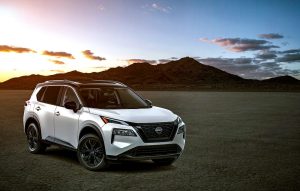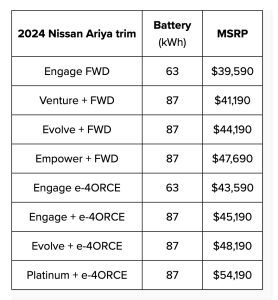Nissan has just announced a fire-sale price reduction on its battery-powered device, the Ariya – which you can now buy for 8-10 percent less than it cost last year. Good luck finding a similar discount on anything that isn’t a device.
Which is why, of course.
Having to cut prices on something is a good indication it’s not selling. Probably because it’s too expensive. Maybe also because it’s just not what people want, irrespective of price.
The Ariya falls into both categories.
Even with the new discount, its base price is $40,000 (Nissan markets this as $39,995 because thirty nine has a better mouth feel than forty – as anyone who just turned 40 knows) is still preposterous money for a small crossover that’s about the same size as another small crossover that isn’t a device, the Rogue – which Nissan sold 271,458 examples of in the United States last year. Without resort to fire-sale prices.
As opposed to the unsustainable 13,464 Ariyas Nissan managed to offload during the same time period. To put the latter figure in some perspective, Chevy sold 34,353 Corvettes in 2023 – and the Corvette is a high-priced toy that is only incidentally useful as a vehicle.
But it is a a fun toy – and that makes it desirable, notwithstanding its limited usefulness as a vehicle.
The Ariya, on the other hand, is an expensive toy that’s neither fun nor useful. In base “just under $40k” trim, it has a best-case range of 205 miles – which is less than half the city range of the same-sized and similarly shaped Rogue. The latter has a highway range of 536 miles, or just shy of three times as far as the best-case range of the Ariya no matter where you try to drive it.
And the Rogue’s range is included in its base price of $28,420.
One of the great grifts of the EV putsch is that you always have to pay extra to get anywhere. Thousands extra. If you want to be able to drive the Ariya farther than 205 miles it’ll cost you over $41k – even with the fire-sale discount. For that you’ll get a device can go about 100 miles less than the Rogue can go in city driving (and about 200 miles shy of how far the Rogue can go on the highway).
And – of course – you have to pay extra (again) to be able to charge any device at home in less than a couple of days. For an electrician to come out and wire up a “Level II” (240V) charging circuit. 
This is dirty business.
Imagine having to pay thousands more to get more than the gas-vehicle equivalent of a tank that can hold more than half a tank. The latter being the rough equivalent of what you get for “$39,995” when you buy an Ariya.
Imagine having to pay more to be able to refuel in less than a day or two.
Which explains why only 13,464 did buy an Ariya last year – and that was with the inducement of the $7,500 federal tax rebate that is not available to Rogue buyers, who don’t have to be bribed to buy one of those.
So, to recap: The device called Ariya costs just shy of $12k more than the otherwise generally similar Rogue – i.e., both are compact-sized crossovers – but the device goes less than half as far, best-case, as the Rogue can go in city driving – where vehicles go least far, because city driving is where they are least fuel-efficient.
City driving is where battery powered devices are most efficient, chiefly because they’re often not moving (or not moving very fast). And the very best this device can deliver is 205 miles – unless you spend a couple thousand more and then you can go another 100 miles, maybe (“up to” 305 miles is what you get for spending $41,190 to buy the Venture + iteration of the device).
In fact, of course, you’ll get less than that – and not just in the “your actual mileage may vary” sense that people are familiar with when it comes to vehicles that aren’t battery powered devices. Depending on how you drive a vehicle, it might get 32 rather than 35 MPG. But there is no analog in vehicle history of a disparity between what is touted and what is actual such as is the case when it comes to devices.
As almost everyone now knows, it is routine for a device’s actual range in real-world driving to be 10-20 percent less than advertised and common for it it be 30 or more percent less – as when it’s very cold outside. Such a disparity would never be tolerated if we were talking about a vehicle. It would be taken as fraud – which it would be – if the vehicle you bought that claimed it could take you 35 miles on a gallon of gas routinely only took you 28 miles (20 percent less) and never mind 25 or less.
People are expected to buy this.
Just as they were expected to buy into being injected with fraudulently advertised mRNA “gene therapy” drugs that were not vaccines, in the commonly understood sense. 
Nissan’s senior director of EV strategy and (wait for it) transformation, Trisha Jung, says “As the electric vehicle market continues to develop and grow, the revised pricing for the 2024 Ariya will improve the model’s competitiveness and ensure we are delivering maximum value to our customers.”
Italics added.
“Maximum value”?
We live in a hallucinatory, clown show world. Squeeze his nose – listen to it honk!
Only it’s not very funny.
. . .
If you like what you’ve found here please consider supporting EPautos.
We depend on you to keep the wheels turning!
Our donate button is here.
If you prefer not to use PayPal, our mailing address is:
EPautos
721 Hummingbird Lane SE
Copper Hill, VA 24079
PS: Get an EPautos magnet or sticker or coaster in return for a $20 or more one-time donation or a $10 or more monthly recurring donation. (Please be sure to tell us you want a magnet or sticker or coaster – and also, provide an address, so we know where to mail the thing!)
If you like items like the Keeeeeeev T shirt pictured below, you can find that and more at the EPautos store!











Nissan as an “also ran” brand will find it extremely hard to complete with selling electric cars. Most of their gas cars don’t have the greatest reputation already.
Empower trim level. Brie was shilling the Z car the last time I saw her in a Nissan ad.
Not quite 39k:
MSRP excludes applicable tax, title, license fees and destination charges. Dealer sets actual price. Prices and specs are subject to change without notice. Destination and handling $1,390.
How fast is this car? I don’t go more than 100 miles per day, and I have a 220 in my garage, so I think I’m going to buy one of these. I want to trade in my old POS mustang for a cool EV, that will smoke all the old muscle cars. I don’t like to do oil changes so that’s a plus. Don’t you guys know that the EV motor is direct drive? And torque, if you ever drive one, you’ll know.
Hi Sterling,
I assume… I hope… you’re joking!
The Ariya device gets to 60 in about five seconds, which would probably beat my old muscle car. But my muscle car would catch up (devices slow down as speed builds) once we get to 80 or so. The ol’ Pumpkin is prolly good for 150 or so. The device can just barely crest 100 – and if you drive it that fast for any length of time, you’ll be waiting a long time. I might have to stop for gas, too. But I’ll be back on the road in less than 5 minutes with a full tank of gas – as opposed to partial charge after 30-45 minutes.
“a cool EV, that will smoke all the old muscle cars”
I’ll gladly challenge you to a cross country race. Device of your choice against either of my 70’s cars.
I AI!
Yup, Eric fell for it!
Anybody “the turd” is a turd.
If the dimwits at Nissan really did care about the Ariya’s “competitiveness” and “maximum value”, they would have refrained from launching it on the market until they had figured out how to ensure that it had price and performance parity with a similar ICE-powered vehicle, such as the Rogue.
The fact that Nissan was content with launching this half-baked dEVice on the market tells us all we need to know about how little they actually care.
If the automakers didn’t release electric cars to the market until they were competitive with gas cars, there would be no electric cars yet, and most likely never…
Indeed – EVs are a dead end, and they disappeared from the market a century ago for a reason. The reintroduction of EVs now only serves to demonstrate why.
Eric,
I have to take issue with you here. Calling the Ariya’s discount a “blue light special” is a misnomer. Why? Because Kmart’s blue light specials were AFFORDABLE! I could call the Ariya many things, but affordable isn’t one of them-even with the 10% “discount”…
Good points, Mark!
I stand corrected…
I miss Kmart. There used to be one just about a mile away from my house and I used to do just about all my shopping there, especially clothes while growing up. It closed four years ago and now I’m reluctantly forced to go to the Walmart in the mall area one town over.
I miss them too. When we were kids, going to Kmart was cool… 🙂
Eric,
Glad to hear about the decline of Ariyan supremacy…
Slightly off topic, but feel free to eviscerate this one:
https://www.vox.com/future-perfect/24086680/speeding-limit-car-crash-accidents-deaths-intelligent-speed-assistance-tech
Whatever “Vox” is, this article is the antithesis of many found on EP Autos. It appears to be much less “Vox Populi” and much more “Vox Imperium”.
It include all your favorites, such as:
“A technology known as Intelligent Speed Assistance (ISA) can make it difficult or impossible for drivers to drastically exceed the posted limit. Over the last few months, a bevy of federal, state, and local officials have called for ISA adoption on all new cars….” (Assistance! Bevy! Officials!)
And…
“There will be visceral opposition from those who view speed-limiting technology as an attack on “freedom,” even though breaking the posted limit is, by definition, already illegal.” (Which was also an attack on freedom, of course.)
Great stuff with which to enter the day, seething with animosity.
Spot on with vox imperium. Here are some of its “funders:”
The Rockefeller Foundation
The Pulitzer Center
Omidyar Network
The National Institute of Health Care Management
New Venture Fund
The Commonwealth Fund. . .
https://www.vox.com/pages/funding
several years ago a coworker bought a NEW Nissan Versa……With a …gasp….manual trans for less than 15K. Its not much to look at but way better than any device. Nissan is finished.
I can afford one vehicle. Not two. Not seven. One. Maybe a motorcycle, but that’s pretty much a fair weather ride for entertainment. That vehicle has to do as much as possible.
My Cherokee is a gas hog. It gets about 22MPG thanks to the M/S tires, V6 and the rest of the Trailhawk package. I take it off road from time to time, not any places where I might need Matt’s Off Road Recovery, but it goes where I want. The biggest problem with the Trailhawk package is the minuscule gas tank, only about 300 miles worth of fuel as it sit today, thanks to the full size spare. But there’s usually fuel stations around, even if I don’t’ get the best price, it’s still only about $40 to fill.
300 mile range isn’t bad when you know you can get more fairly quickly. If you’re going to need 45 minutes to recharge, that’s a problem. An EV should make sense for commuting, with routine driving and set distances. Just plug it in when you get home and top off. But not at these prices, not with all the incremental costs of property tax, insurance and registration. Not to mention storing it somewhere.
Just plug it in when you get home and top off.
And then wait, and wait, and wait, and wait, and wait…
What is (or will be) the ultimate cost of disposing of these devices? Can they go to the land fill or the EV junk yard or is that a problem yet to be solved (or foisted as a future tax upon the dumb proletariat who buy these things?
Trisha Jung, says “As the electric vehicle market continues to develop and grow, the revised pricing for the 2024 Ariya will improve the model’s competitiveness and ensure we are delivering maximum value to our customers.”
So, you were not delivering max value to your customers in the first place? Stickin it to the customer? Nice Bud Light marketing strategy. You’re fired Trisha.
I have a question about “range”. If it can be increased by an over-the-air software update, a la Tesla vs the Hurricane, why not offer it as standard? It’s not like they have additional manufacturing operations that must be included and more expensive parts. It’s just a flippin’ key stroke for Heaven’s sake!
If your product isn’t selling do the least expensive thing you can to make it more attractive. In this case it would seem that the cost is $0. It makes no sense.
Trade off is draining the battery to the point of damage. The Hurricane mode didn’t really add much range either, maybe about 50 miles or so.
A small case might be made for EV’s if they were half the price of an ICE car because their shorter life span would be less of an issue along with waiting to charge because it cost half as much.
Since they cost almost twice as much as a comparable ICE car their is of course no case for any of them. A reasonably well maintained ICE car can run for decades at a reasonable cost. An EV nope.
I’m wondering if a really old, smashed up EV even has any value or do you have to pay money to get rid of it due to those flammable batteries?
Hi Landru,
A device with a dead battery is essentially worthless as the cost of the device relative to the value of the device is disproportionately unfavorable. That is why people throw away devices with dead batteries.
By value I meant to a junk yard or the charity’s that take your car away and give you a tax receipt for its scrap value.
I’m guessing it’s very low due to the labor required to remove the battery pack vs draining the fluids out and crushing it then.
If I were a scrapper, the tires/wheels, copper wire, rear view mirror may be worth something. Otherwise the only future I can see for it is as the propulsion for a parade float.
On second thought, I can see a headline shouting “Tournament of Roses cancelled after eeeeeveee battery self immolates & destroys all pararde floats”.
Feelin’ snarky today…
You could probably donate it to your local fire department for burn training and take a tax deduction for part of the claimed value of the device. That used to be a way of getting rid of a vehicle you couldn’t sell- I did it a few times years ago. Though I figured out that just outright salvage and scrap ended up putting more money in my pocket than the alleged tax deduction.
Unfortunately due to the toxic nature of these things there will probably be multiple levels of bureaucrat fighting to prevent that. But maybe not until it becomes a widespread practice.
I’m wondering if a really old, smashed up EV even has any value or do you have to pay money to get rid of it due to those flammable batteries?
With a few explosives added to the mix, it might have some entertainment value, at least (the EV doesn’t have to be old or smashed up for that, though – any EV will do):
https://www.youtube.com/watch?v=DG9Izqp6WWU
As a reminder, today is the deadline for comments on NHTSA’s advanced drunk and impaired driving technology (alcohol sensors).
It is as easy as posting a comment here. Go to regulations dot gov. Enter docket number NHTSA-2022-0079-0015 to bring up the comment form. Type your words in the box. Check a couple of other boxes; hit send. It can be done in five minutes.
I urged NHTSA to inform Congress that sufficiently accurate alcohol sensors don’t exist. Therefore, all work should cease on this impracticable quest.
Regulations dot gov just confirmed my comment by email, with all the paragraphs removed. Here I restore them:
In a Dec 12, 2023 Reuters article, Acting NHTSA Administrator Ann Carlson pointed out the fundamental, insoluble problem with this proposed rulemaking:
‘Carlson said there were close to 1 billion separate daily driving journeys in the United States. “If it’s 99.9% accurate, you could have a million false positives. Those false positives could be somebody trying to get to the hospital for an emergency.”‘
Remote alcohol sensors cannot possibly achieve 99.9% accuracy. If they somehow did, a million false positives a day would remain grossly unacceptable.
In summarizing the thousands of comments received, NHTSA should inform Congress that suitable technology does not exist for advanced drunk and impaired driving prevention, and is unlikely to be developed.
Therefore, NHTSA should cease and desist from any further work in response to a wholly unrealistic statutory mandate. Like King Canute, Congress cannot push back the tide, nor can it command a sufficiently accurate alcohol sensor into existence. Please, JUST STOP.
Remote alcohol sensors cannot possibly achieve 99.9% accuracy. If they somehow did, a million false positives a day would remain grossly unacceptable.
That’s not a bug, it’s a feature. Once these things start pushing out false positives watch the fun as some grad student thesis grinds out the flawed statistics. Then watch as the story gets propagated through the “local” news (television station networks like Tegna are about as local as the McDonalds inside Walmart): “Shocking news tonight from those new alcohol sensors in your car… Our own consumer affairs reporter Flip Blowdri has the details.” Then six months later the study gets redacted, but no one remembers that, or worse, they double down COVID vaccine style.
Problem is Jim, Clowngress thinks that they CAN push back the tide, a la Captain Picard saying “make it so.” Next week we’ll still be having hangover symptoms from them mandating the times of sunrise and sunset.
‘Nissan’s senior director of EV strategy and (wait for it) transformation, Trisha Jung.’ — eric
One is not surprised to learn that ‘Trisha Jung’ is a graduate of … wait for it … Hahhhhhvid Business School.
https://www.linkedin.com/in/trisha-jung-34240a12
Trisha’s Folly, a future HBS case study can be titled. Girl Gone Goofball, in the video version.
Squeeze her Nose …